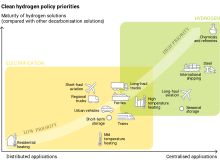
Back Waterstof se kleure Afrikaans اقتصاد الهيدروجين Arabic قتيصاد د لهيدروجين ARY Hidrogen enerjisi Azerbaijani Водородна енергетика Bulgarian Economia de l'hidrogen Catalan Wasserstoffwirtschaft German Hidrogena civilizacio Esperanto Economía de hidrógeno Spanish Vesinikuenergeetika Estonian
It has been suggested that this article be merged into Low-carbon economy. (Discuss) Proposed since March 2024. |

The hydrogen economy is an umbrella term that draws together the roles hydrogen can play alongside low-carbon electricity to decarbonize those sectors and activities which may be technically difficult to decarbonize through other means, or where cheaper and more energy-efficient clean solutions are not available.[2] In this context, hydrogen economy encompasses hydrogen's production through to end-uses in ways that substantively contribute to phasing-out fossil fuels and limiting climate change.
Most hydrogen produced today is gray hydrogen, made from natural gas through steam methane reforming (SMR) which accounted for 1.8% of global greenhouse gas emissions in 2021.[3] Low-carbon hydrogen, which is made using SMR with carbon capture and storage (blue hydrogen), or through electrolysis of water using renewable power (green hydrogen), accounted for under 1% of production.[4] Virtually all of the 100 million tonnes[5] of hydrogen produced each year is used in oil refining (43% in 2021) and industry (57%), principally in the manufacture of ammonia for fertilizers, and methanol.[6]: 18, 22, 29
In its contribution to limiting global warming to 1.5 °C, it is broadly envisaged that the future hydrogen economy replaces gray hydrogen with blue and predominantly green hydrogen, produced in greater total volumes, to provide for an expanded set of end-uses.[7] These are likely to be in heavy industry (e.g. high temperature processes alongside electricity, feedstock for production of green ammonia and organic chemicals, as alternative to coal-derived coke for steelmaking), long-haul transport (e.g. shipping, aviation and to a lesser extent heavy goods vehicles), and long-term energy storage.[7][8] Other applications, such as light duty vehicles and heating in buildings, are no longer part of the future hydrogen economy, primarily for economic and environmental reasons.[9][10] These reasons include the difficulty of developing long-term storage, pipelines, and engine equipment, safety concerns since hydrogen is highly explosive, and the inefficiency of hydrogen compared to direct use of electricity.
As of 2023[update] there are no real alternatives to hydrogen for ammonia production for fertilizer, hydrogenation, hydrocracking, and hydrodesulfurization.[11] The extent to which hydrogen will be used to decarbonise chemical feedstock, long haul aviation and shipping, and long-term energy storage is likely to be influenced by the evolving production costs of low- and zero-carbon hydrogen. Estimates of future costs face numerous uncertainties – such as the introduction of carbon taxes, geography and geopolitics of energy, energy prices, technology choices, and their raw material requirements – but it is likely that green or white (underground[12]) hydrogen will see the greatest reductions in production cost over time.[13]
- ^ International Renewable Energy Agency (2022-03-29). "World Energy Transitions Outlook 1-5C Pathway 2022 edition". IRENA. p. 227. Retrieved 2023-10-06.
- ^ Cite error: The named reference
:0was invoked but never defined (see the help page). - ^ Greenhouse gas emissions totalled 49.3 Gigatonnes CO2e in 2021."Global Greenhouse Gas Emissions: 1990–2020 and Preliminary 2021 Estimates". Rhodium Group. 19 December 2022. Retrieved 2023-09-21.
- ^ "Hydrogen". IEA. 10 July 2023. "Energy" section. Retrieved 2023-09-21.
- ^ "Hydrogen". IEA. Retrieved 2024-03-24.
- ^ IEA (2022). Global Hydrogen Review 2022. International Energy Agency. Retrieved 2023-08-25.
- ^ a b IPCC (2022). Shukla, P.R.; Skea, J.; Slade, R.; Al Khourdajie, A.; et al. (eds.). Climate Change 2022: Mitigation of Climate Change (PDF). Contribution of Working Group III to the Sixth Assessment Report of the Intergovernmental Panel on Climate Change. Cambridge, UK and New York, NY, US: Cambridge University Press (In Press). pp. 91–92. doi:10.1017/9781009157926. ISBN 9781009157926.
- ^ IRENA (2021). "World Energy Transitions Outlook: 1.5 °C Pathway". International Renewable Energy Agency. Abu Dhabi. p. 95. Retrieved 2023-09-21.
- ^ Plötz, Patrick (2022-01-31). "Hydrogen technology is unlikely to play a major role in sustainable road transport". Nature Electronics. 5 (1): 8–10. doi:10.1038/s41928-021-00706-6. ISSN 2520-1131. S2CID 246465284.
- ^ Rosenow, Jan (September 2022). "Is heating homes with hydrogen all but a pipe dream? An evidence review". Joule. 6 (10): 2225–2228. doi:10.1016/j.joule.2022.08.015. S2CID 252584593.
- ^ Barnard, Michael (2023-10-22). "What's New On The Rungs Of Liebreich's Hydrogen Ladder?". CleanTechnica. Retrieved 2024-02-17.
- ^ Paddison, Laura (2023-10-29). "They went hunting for fossil fuels. What they found could help save the world". CNN. Retrieved 2024-02-17.
- ^ Goldman Sachs Research. "Carbonomics: The Clean Hydrogen Revolution". Goldman Sachs. pp. 4–6. Retrieved 2023-09-25.
© MMXXIII Rich X Search. We shall prevail. All rights reserved. Rich X Search